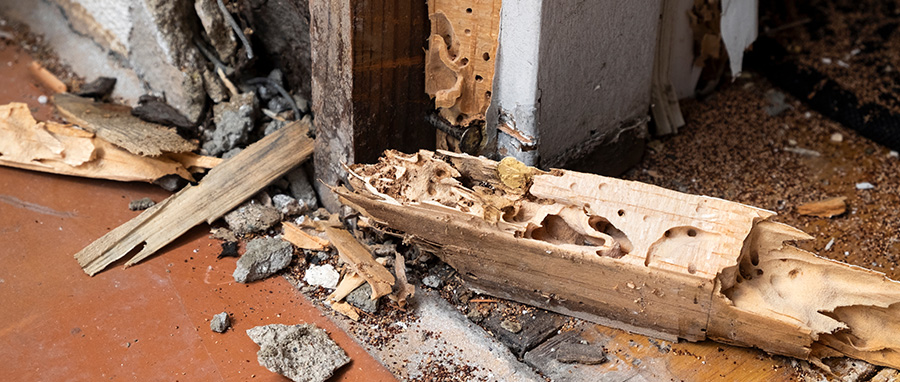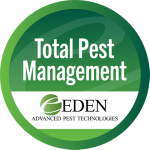There’s probably no pest more feared by homeowners than the termite. This little creature might be tiny, but it brings with it the power to destroy any wooden structure it comes against. If you suspect your home might be infested with termites, there’s already a chance that the insects have caused serious damage somewhere in your walls or support beams. But, how exactly do termites destroy homes, what does the damage look like, and is it really all that bad?
What Does Termite Damage Look Like?
Termite damage can vary in appearance depending on the severity of the infestation and the type of termites involved. Recognizing the signs of termite damage early on can help homeowners take prompt action to address the issue and prevent further destruction to their property. Here are some common indicators of termite damage to watch out for:
- Hollowed-Out Wood: Termites feed on wood from the inside out, leaving behind hollowed-out galleries within wooden structures. If you tap or knock on an area of wood affected by termites, it may sound hollow or papery.
- Buckling or Sagging Floors: Subterranean termites, which typically nest in the soil and travel through mud tubes, can cause floors to buckle or sag as they consume wooden support beams beneath the surface.
- Bubbling or Peeling Paint: As termites tunnel through wood, they can disrupt the paint or finish on the surface, causing it to bubble, crack, or peel. This can be particularly evident around windows, doors, and baseboards.
- Mud Tubes: Subterranean termites build mud tubes to provide moisture and protection as they travel between their nest and a food source. These tubes, which are typically brown or tan in color and about the width of a pencil, may be visible along the foundation, walls, or other surfaces.
- Frass Deposits: Termites produce tiny pellets of digested wood, known as frass, which they push out of their tunnels. Accumulations of frass may be found near termite nesting sites or beneath infested wood.
- Sagging or Warped Ceilings: In severe cases of termite damage, ceilings may exhibit signs of sagging or warping due to weakened support beams. This can pose a serious safety hazard and requires immediate attention.
- Visible Termite Swarmers: During certain times of the year, termite swarmers, or winged reproductive termites, may emerge from colonies to establish new nests. These swarmers resemble flying ants and are often seen near light sources or windows.
It’s important to note that termite damage can sometimes be subtle and easily overlooked, especially in the early stages of an infestation. Regular inspections of your home, particularly in areas prone to moisture or wood contact with soil, can help detect signs of termite activity before significant damage occurs.
Can You Repair Termite Damage?
Termite damage can range from minor surface imperfections to severe structural compromises, depending on factors such as the duration and extent of the infestation. While termite damage can be extensive and costly to repair, it is often entirely possible to restore affected structures to their original condition. However, the process typically involves several steps and may require the expertise of both pest control professionals and repair contractors.
How Much Does It Cost To Repair Termite Damage?
One of the most significant concerns associated with severe termite damage is the cost of repair. Extensive termite infestations can cause substantial damage to wooden structures, including support beams, flooring, and walls. Repairs can range from hundreds to thousands of dollars depending on the severity.
Repairing or replacing these damaged components can be costly, particularly if structural renovations are required. Homeowners may also incur additional expenses for pest control treatments, inspections, and preventative measures to protect against future infestations.
Thankfully, situations where a home is completely destroyed by termites are extremely rare—while these pests are common, you’re likely to notice at least some damage before it becomes severe enough to necessitate evacuation or massive rebuilding projects.
Tips for Avoiding Termite Damage
Preventing termite infestations is key to avoiding costly damage to your home. By taking proactive measures to make your property less attractive to termites, you can reduce the risk of infestation and protect your investment. Here are some tips to help you avoid termite damage:
- Eliminate Moisture Sources: Termites are attracted to moisture, so it’s essential to address any sources of water accumulation around your home. Fix leaky faucets, repair plumbing leaks, and ensure proper drainage away from the foundation.
- Reduce Wood-to-Soil Contact: Termites gain access to homes through direct contact with soil, so minimize wood-to-soil contact wherever possible. Keep firewood, mulch, and wooden debris away from the foundation, and use concrete or metal barriers to separate soil from wooden structures.
- Maintain Ventilation: Proper ventilation helps prevent moisture buildup in crawl spaces, attics, and basements, making these areas less hospitable to termites. Ensure vents are unobstructed and functioning correctly to promote airflow and reduce humidity levels.
- Inspect Regularly: Conduct regular inspections of your home for signs of termite activity, such as mud tubes, discarded wings, or damaged wood. Pay particular attention to areas prone to moisture, such as basements, crawl spaces, and around plumbing fixtures.
- Invest in Professional Pest Control: Consider hiring a professional pest control service to conduct regular inspections and implement preventative treatments. Pest control professionals have the expertise and resources to identify potential termite threats and take proactive measures to protect your home.
What To Do If You Have Termites
Well, the first thing to realize is that, by the time you’ve noticed something, they’ve most likely been at work for a while. This means you can expect there to be some damage. But that doesn’t mean all hope is lost! You might imagine that the next thing to happen will be your entire house covered in large sheets of plastic, being fumigated. While drastic measures sometimes do happen, the truth is that once found, a termite infestation can often be dealt with rather quickly. It’s what happens after that can be a problem.
If you come across termites in your property, the first thing you should do is contact a professional termite exterminator. Attempting to eliminate these pests on your own is extremely difficult and often outright impossible. Qualified experts know how to identify the species, extent of the infestation, and potential causes. They’ll help you create a reliable plan to protect your space long-term.
Prevent Termite Damage With Eden Advanced Pest Technologies
Don’t let termites threaten the safety and integrity of your home. With [Company]’s expert pest control services, you can safeguard your property against termite infestations and minimize the risk of costly damage. Contact us today to schedule a comprehensive inspection and learn more about our proactive termite prevention solutions.
Back to Termite Exterminators & Control

